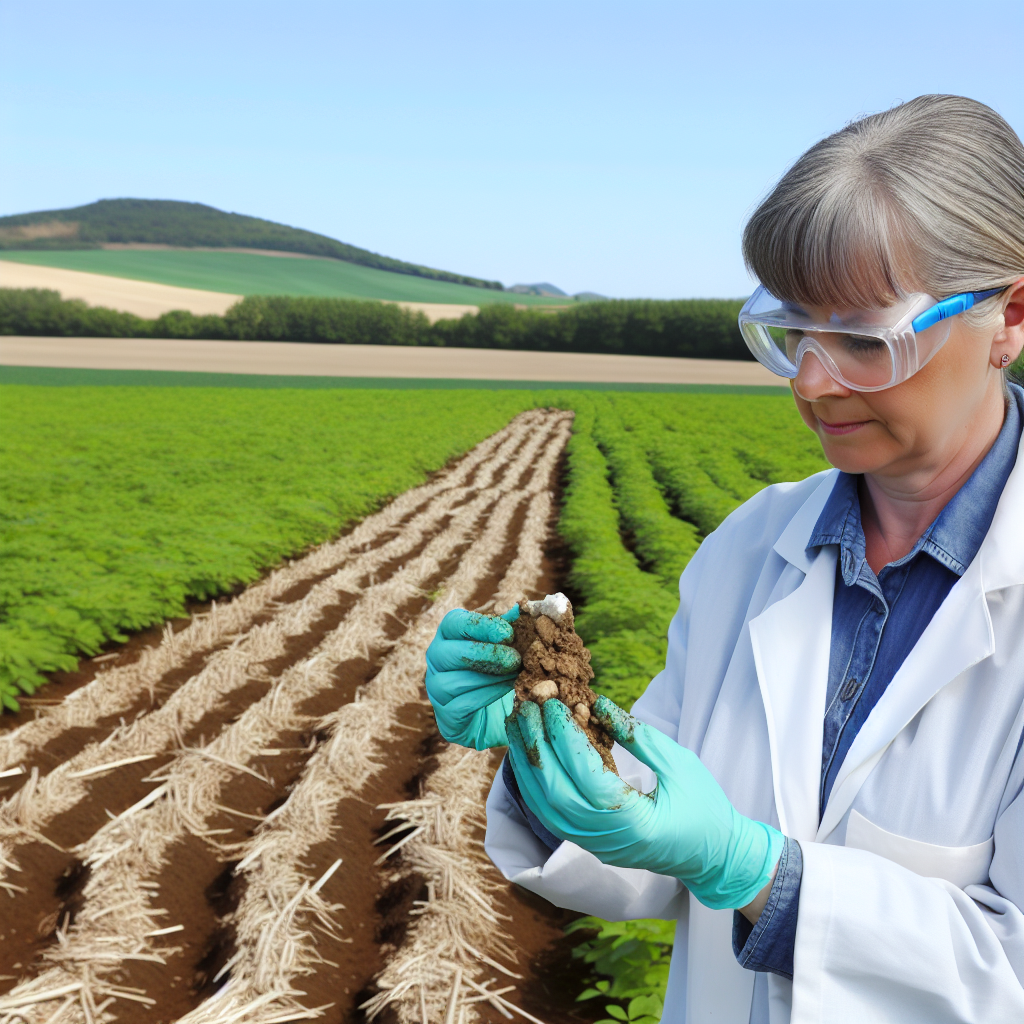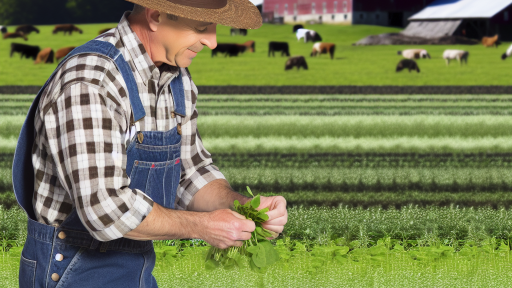Introduction to Soil Degradation
Understanding Soil Degradation
Soy degradation refers to the decline in soil quality.
This decline negatively affects agricultural productivity.
Key factors contribute to this serious issue.
Causes of Soil Degradation
One major cause is deforestation.
When trees are removed, soil becomes more vulnerable.
Another cause is overgrazing by livestock.
This process leads to soil compaction and erosion.
Moreover, excessive use of chemical fertilizers harms soil health.
These chemicals disrupt the natural balance of nutrients.
Additionally, poor agricultural practices worsen soil conditions.
For instance, monoculture leads to the depletion of specific nutrients.
Consequences of Soil Degradation
Soil degradation has severe consequences for ecosystems.
It diminishes biodiversity by destroying habitats.
Furthermore, it leads to reduced agricultural yields.
This situation threatens food security worldwide.
Transform Your Agribusiness
Unlock your farm's potential with expert advice tailored to your needs. Get actionable steps that drive real results.
Get StartedWater quality also suffers due to increased runoff.
Consequently, sediment and pollutants contaminate water supplies.
In the long term, soil degradation can result in desertification.
Thus, sustainable soil management practices are urgently needed.
The Importance of Soil Health for Sustainable Agriculture
Understanding Soil Health
Soy health plays a crucial role in sustainable agriculture.
Healthy soil supports plant growth and resilience.
It serves as a habitat for diverse organisms.
Moreover, it aids in the cycling of nutrients essential for crops.
Benefits of Healthy Soil
Healthy soil promotes increased agricultural productivity.
It enhances water filtration and retention abilities.
This leads to better drought resistance in crops.
Additionally, healthy soil reduces erosion and runoff.
Thus, it contributes to environmental sustainability.
Impact on Food Security
Soy health directly influences food security worldwide.
It ensures consistent production of high-quality crops.
Moreover, it helps in maintaining local ecosystems.
Healthy soils support farmers in adapting to climate change.
As a result, they can sustain food supplies for future generations.
Economic Considerations
Investing in soil health positively impacts farmers’ incomes.
Healthy soils lead to lower input costs for fertilizers and pesticides.
As soil quality improves, yields increase, driving profits up.
Additionally, sustainable practices help maintain soil productivity over time.
This builds a more resilient agricultural economy.
Practical Strategies for Soil Health
Farmers can adopt multiple strategies for improving soil health.
Showcase Your Farming Business
Publish your professional farming services profile on our blog for a one-time fee of $200 and reach a dedicated audience of farmers and agribusiness owners.
Publish Your ProfilePractices such as crop rotation and cover cropping are effective.
These methods enhance biodiversity and soil structure.
Furthermore, reducing tillage minimizes soil disturbance.
Applying organic matter enriches soil and fosters beneficial organisms.
Smart Agricultural Practices to Prevent Soil Erosion
Importance of Soil Conservation
Soil conservation plays a vital role in agriculture.
Healthy soil supports crop growth and sustains ecosystems.
Therefore, farmers must adopt practices that preserve soil quality.
Cover Cropping
Cover cropping is an effective strategy for soil protection.
This practice involves growing specific crops to cover the soil.
These crops help prevent erosion during non-growing seasons.
Additionally, they contribute organic material and nutrients.
Farmers should choose local species suited to their climate.
Conservation Tillage
Conservation tillage minimizes soil disturbance.
By leaving crop residues on the surface, this method protects soil structure.
This practice also increases water retention in the soil.
Moreover, it reduces erosion by wind and water runoff.
Buffer Strips
Buffer strips serve as a natural barrier against erosion.
Planting vegetation along waterways slows down runoff.
These strips filter pollutants and nutrients from the agricultural land.
Moreover, they enhance biodiversity by providing habitat for wildlife.
Rotational Grazing
Rotational grazing prevents overgrazing in pastures.
This practice involves moving livestock between different grazing areas.
By doing so, it allows for grass recovery and soil regeneration.
Moreover, healthy pastures contribute to soil structure and fertility.
Soil Testing and Amendments
Regular soil testing helps identify nutrient deficiencies.
Farmers can then apply appropriate amendments for soil health.
These amendments enhance fertility and prevent degradation.
Additionally, proper pH levels can increase nutrient availability.
Agroforestry Practices
Agroforestry incorporates trees into agricultural systems.
This practice helps prevent soil erosion by stabilizing the soil.
Trees act as windbreaks, reducing the force of wind on crops.
Furthermore, woody plants contribute organic matter and nutrients.
Utilizing Technology
Modern technology aids farmers in managing soil health.
Tools like precision agriculture optimize resource use efficiently.
Farmers can monitor soil moisture and nutrient levels closely.
This information supports timely and effective decision-making.
You Might Also Like: Integrated Pest Management After Harvest
Utilizing Cover Crops to Enhance Soil Structure and Fertility
Benefits of Cover Crops
Cover crops provide numerous benefits for soil health.
They reduce soil erosion by retaining soil structure.
Moreover, cover crops improve soil fertility through nutrient cycling.
Showcase Your Farming Business
Publish your professional farming services profile on our blog for a one-time fee of $200 and reach a dedicated audience of farmers and agribusiness owners.
Publish Your ProfileThey also enhance microbial activity, which is vital for soil health.
Additionally, these crops help suppress weeds effectively.
Types of Cover Crops to Consider
Various cover crops are suitable for different soil types.
Legumes, such as clover and vetch, fix nitrogen in the soil.
Grasses, like rye and oats, improve soil structure and prevent erosion.
Brassicas, including radishes, enhance soil aeration with their extensive root systems.
Best Practices for Implementing Cover Crops
Choosing the right cover crop depends on your main crop rotation.
It is essential to plant cover crops during the off-season.
Utilizing a variety of cover crops can maximize benefits.
Ensuring proper termination before planting spring crops is crucial.
Regular monitoring of soil conditions will guide future practices.
Case Studies of Successful Implementation
Many farmers have successfully implemented cover cropping systems.
For instance, the McGregor family in Ohio noticed a significant increase in soil health.
They reported reduced fertilizer costs after using legumes as cover crops.
Another example is the Martinez farm in California, which enhanced biodiversity.
Impacts of Cover Cropping on Soil Health
Incorporating cover crops into your farming practices fosters healthier soils.
This method effectively prevents soil degradation while boosting productivity.
See Related Content: Choosing the Right Cover Crop for Your Farm
Implementing Crop Rotation for Soil Nutrient Balance
Understanding Crop Rotation
Crop rotation involves planting different crops in a sequential pattern.
This method enhances soil fertility and structure.
It helps break pest and disease cycles effectively.
Moreover, crop rotation can reduce the need for chemical fertilizers and pesticides.
Benefits of Crop Rotation
Crop rotation promotes diverse root structures in the soil.
These varied roots improve soil aggregation and prevent erosion.
Additionally, different crops utilize nutrients at varying depths.
This strategy helps maintain a balanced soil nutrient profile.
Best Practices for Implementing Crop Rotation
Choose crops with different nutrient requirements for rotation.
Legumes, for example, can fix nitrogen in the soil.
Include deep-rooted plants to access nutrients unavailable to shallow roots.
Moreover, plan rotations based on local climate and soil conditions.
Challenges to Consider
Some farmers may face challenges in accessing diverse seeds.
Additionally, there can be a learning curve in understanding plant benefits.
Moreover, market demands may influence crop selections.
However, education and support can help mitigate these challenges.
Monitoring and Adjusting Practices
Regularly assess soil health and nutrient levels after rotations.
Consider utilizing soil tests to inform future crop choices.
Adjust crop patterns based on observed results and pest activities.
Continual learning and adaptation will lead to successful crop rotation.
Discover More: Remote Sensing Technologies In Agricultural Management
The Role of Organic Matter in Preventing Soil Degradation
Importance of Organic Matter
Organic matter serves as the backbone of healthy soil.
Showcase Your Farming Business
Publish your professional farming services profile on our blog for a one-time fee of $200 and reach a dedicated audience of farmers and agribusiness owners.
Publish Your ProfileIt enhances soil structure and improves its ability to retain moisture.
Moreover, it enriches the soil with essential nutrients.
This nutrient enrichment fosters healthier plant growth.
Improving Soil Structure
Organic matter significantly improves soil structure.
Additionally, it increases soil aeration and water infiltration.
This leads to a more resilient ecosystem.
Consequently, it helps prevent soil erosion.
Healthy soil structure supports root development.
Enhancing Nutrient Availability
Organic matter plays a vital role in nutrient cycling.
It enhances the availability of macronutrients, such as nitrogen and phosphorus.
Soil organisms decompose organic material, releasing these nutrients.
Therefore, plants can access these nutrients more effectively.
This process is crucial for sustaining crop yields.
Promoting Soil Biodiversity
Organic matter promotes a diverse array of soil organisms.
These organisms contribute to the overall health of the soil ecosystem.
Specifically, they break down organic materials into humus.
This transformation improves soil fertility over time.
Furthermore, a biodiverse soil community enhances resilience against pests.
Implementing Best Practices
Farmers can incorporate organic matter through various methods.
Cover cropping is an effective strategy that enhances soil health.
Additionally, reduced tillage minimizes soil disturbance.
Composting organic waste also enriches soil with essential nutrients.
Overall, these practices foster sustainable agriculture.
Learn More: Best Cover Crops to Improve Soil Fertility

Techniques for Sustainable Water Management and Soil Conservation
Implementing Effective Water Management
Effective water management starts with understanding our water sources.
Utilizing rainwater harvesting systems captures rainfall efficiently.
This technique reduces reliance on groundwater.
Furthermore, implementing drip irrigation optimizes water use.
Drip systems deliver water directly to plant roots.
This method significantly decreases water wastage.
Promoting Soil Health
Soil health is critical for sustainable agriculture.
Practicing crop rotation enhances soil fertility and biodiversity.
This technique helps break pest and disease cycles.
Additionally, cover crops protect against soil erosion during off-seasons.
These crops also improve soil structure and nutrient content.
Utilizing Mulching Techniques
Mulching is a vital practice for soil conservation.
Organic mulches retain moisture and suppress weeds effectively.
Applying mulch reduces the soil temperature fluctuations.
This technique enhances microbial activity, benefiting plant growth.
Implementing Conservation Tillage
Conservation tillage minimizes soil disturbance.
Showcase Your Farming Business
Publish your professional farming services profile on our blog for a one-time fee of $200 and reach a dedicated audience of farmers and agribusiness owners.
Publish Your ProfileThis method preserves soil structure and health.
Furthermore, it reduces erosion and enhances water retention.
Farmers adopting this practice report improved crop yields over time.
Consequently, conservation tillage promotes ecological balance.
Integrating Agroforestry Practices
Agroforestry combines agriculture and forestry in a sustainable manner.
This practice enhances biodiversity on farmlands.
Integrating trees with crops improves soil quality and moisture retention.
Furthermore, trees provide shade and reduce temperature extremes.
This holistic approach contributes to ecosystem sustainability.
Emphasizing Education and Community Involvement
Education is fundamental for effective soil management.
Farmers need access to training on best practices.
Community programs enhance knowledge sharing among farmers.
Additionally, workshops can foster collaboration and innovation.
Building a community around sustainable practices will yield better results.
Integrating Technology: Precision Agriculture’s Role in Soil Health
Overview of Precision Agriculture
Precision agriculture leverages technology to enhance farming practices.
This method helps to maintain soil health effectively.
Farmers can use data-driven strategies for better crop management.
Hence, precision agriculture reduces soil degradation risks.
Data Collection and Analysis
The first step in precision agriculture involves data collection.
Farmers can gather information on soil moisture levels.
Additionally, they can monitor nutrient availability using sensors.
Analyzing this data allows for targeted interventions.
Implementing Smart Practices
Smart practices arise from insightful data analysis.
For instance, farmers might adjust irrigation based on real-time data.
This practice helps in preventing waterlogging and soil erosion.
Moreover, nutrient management can be tailored to specific field zones.
Technology Tools in Use
Several tools support precision agriculture’s effectiveness.
GPS technology plays a crucial role in field mapping.
Drones provide aerial imagery for crop assessment.
These tools enhance monitoring and management capabilities.
Benefits of Precision Agriculture
Precision agriculture offers diverse benefits for soil health.
It reduces chemical inputs, leading to healthier ecosystems.
Furthermore, it enhances crop yields sustainably.
This approach also contributes to long-term soil fertility.
Case Studies and Success Stories
Numerous farms have experienced success through precision agriculture.
For example, Sunny Acres Farm increased yield by 20% last year.
By using soil sensors, they fine-tuned their fertilization schedule.
Such successes illustrate the potential of smart practices in agriculture.
Community Engagement and Education in Soil Conservation Efforts
Importance of Community Involvement
Community involvement is vital in soil conservation efforts.
Engaging local populations fosters a sense of ownership.
Showcase Your Farming Business
Publish your professional farming services profile on our blog for a one-time fee of $200 and reach a dedicated audience of farmers and agribusiness owners.
Publish Your ProfileThis ownership motivates individuals to take action.
Additionally, local communities understand their land better.
They can identify issues and propose relevant solutions.
Educational Programs for Awareness
Educational programs raise awareness about soil degradation.
Workshops present sustainable practices to community members.
Furthermore, information dissemination enhances understanding.
Online resources can also reach a wider audience.
Schools can integrate soil conservation into their curricula.
This approach cultivates awareness from a young age.
Partnerships with Local Organizations
Partnerships with local organizations amplify conservation efforts.
Collaboration brings together diverse resources and expertise.
Nonprofits can sponsor educational workshops and events.
Local farmers can share their experiences with sustainable practices.
These shared efforts foster community bonding and support.
Implementing Practical Soil Conservation Techniques
Hands-on experiences help reinforce theoretical knowledge.
Community-led initiatives can establish demonstration projects.
These practices showcase the benefits of soil conservation.
Moreover, community members can observe results firsthand.
Engagement in practical activities encourages long-term commitment.
Monitoring and Feedback Mechanisms
Monitoring programs ensure the effectiveness of soil conservation efforts.
Feedback mechanisms promote adaptation and improvement.
Community members can report challenges they face.
This feedback helps refine strategies and enhance practices.
Continuous learning ensures practices remain relevant.
Additional Resources
Chapter 5 : Food Security — Special Report on Climate Change and …
Climate-Smart Agriculture and Forestry Resources | Farmers.gov




